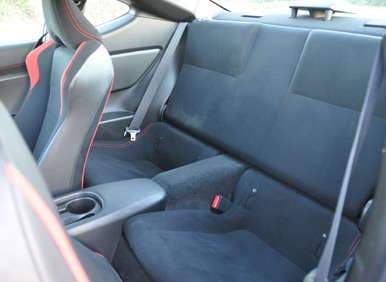Recent Articles
Popular Makes
Body Types
2013 Scion FR-S Road Test and Review
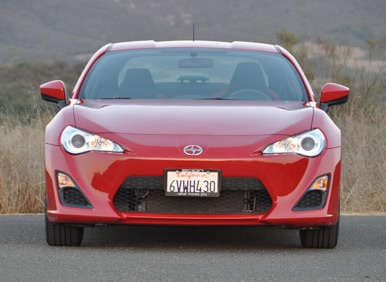
Subaru is known for its all-wheel-drive systems, but apparently, Toyota had its corporate eye on a different prize when it hatched the idea of building an affordable front-engine, rear-drive, 2+2 sports car: the low center of gravity inherent with a horizontally-opposed, or boxer, engine.
Toyota owns a 16.5-percent stake in Subaru, and tapped its partner to supply a boxer engine for its new FT-86 sports car, a modern homage to the iconic Corolla AE86. Introduced in 1983 and sold in North America in coupe and three-door hatchback body styles, our version of the AE-86 was called the Corolla GT-S. A lightweight, rear-drive, econo-sized pocket rocket, the Corolla GT-S was a blast to drive because it tended to oversteer rather than understeer, the former trait an inherent flaw in the Chevy Cavalier Z24, Dodge Omni GLH, Ford Escort GT, Honda Civic Si, and Volkswagen Rabbit GTI of the time. Unless you yanked on the e-brake handle, that is.
Fast-forward 30 years, and the Toyota FT-86 (known as the Scion FR-S in the States – front-engine, rear-drive, sport) picks up where the AE86 left off, but this time around it’s a genuine sports car rather than a sporty car.
2013 Scion FR-S Review: Pricing and Trim Levels
Though the FR-S is the most expensive Scion, the car is a relative bargain considering its engineering and performance. If you can row your own gears, the starting price is $24,955 for the model with the manual gearbox. If not, you need the automatic transmission, which adds $1,100. All FR-S coupes come standard with a Scion Service Boost, free scheduled maintenance for the first two years or 25,000 miles of ownership.
The Scion FR-S is a well-equipped mono-spec vehicle that offers a handful of dealer-installed options. The most significant of these is a premium BeSpoke audio system ($845) with a color LCD touchscreen, voice-recognition technology, HD Radio, iTunes tagging capability, and Bluetooth music streaming with Pandora Internet radio.
If you want leather seats with Alcantara inserts, heated front seats, heated exterior mirrors, keyless entry with push-button ignition, and automatic climate control, you’ll need to shop at the Subaru store for the essentially identical BRZ, but in fancier Limited trim.
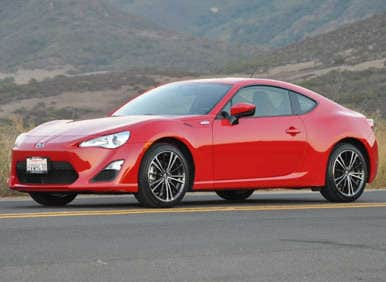
2013 Scion FR-S Review: What It’s Up Against
Given its affordable price point, the 2013 Scion FR-S competes with a variety of compact performance cars, ranging from the new Ford Focus ST and turbocharged Mazdaspeed 3 to the venerable Honda Civic Si and legendary Volkswagen GTI.
You will notice that, just as the Corolla GT-S was positioned against a squadron of front-drivers, the same is true 30 years later.
Also, given its useless rear seat, the FR-S is a legitimate sunscreen-not-required alternative to a Mazda MX-5 Miata.
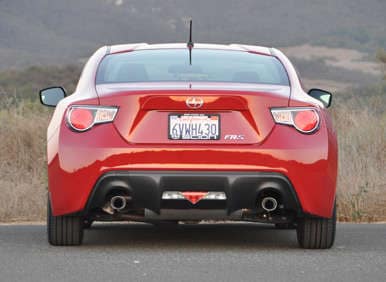
2013 Scion FR-S Review: Exterior
What’s New for 2013:
- Front-engine
- Rear-drive
- Sport
How It Looks:
The Scion FR-S is clearly Japanese, looking like one of those generic sports cars created by video game makers too cheap to license the rights to the real thing. Add a healthy dose of anime-inspired exaggeration, which is really noticeable as you run your hands over the car during a wash, combined with cab-rearward proportions, swollen fenders, and an angry visage, and the FR-S definitely stands out from a crowd.
My favorite FR-S detail is the “86” badge located just aft of the faux front fender vent. My least favorite FR-S detail is the wheel design. Lots of automakers are employing machined-finish multi-spoke wheels with black painted pockets now, and these split-spoke rims look both plain and delicate. Plus, they’re identical to what Subaru bolts onto the BRZ. I definitely think there’s an opportunity for Scion dealers to upsell FR-S buyers with a variety of Toyota Racing Development wheels in both 17- and 18-inch sizes.
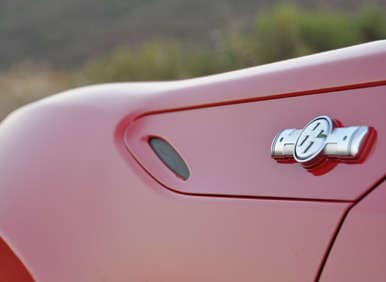
2013 Scion FR-S Review: Interior
What’s New for 2013:
- 2+2 seating, if the second two don’t have any legs
How It Looks and Feels:
Historically, Scion models have featured super-cheap interior fittings. That’s not the case inside the FR-S, and while much of the secondary switchgear is obviously sourced from the Toyota parts bin, there are few egregiously inexpensive looking and feeling materials inside this car’s cabin.
Aside from the stereo, which is apparently designed to resemble an aftermarket unit with similar ergonomic failings, the FR-S is minimalistic and purposeful. Check out the way the dashtop speaker grilles are styled to appear as though they are tautly stretched over the underlying components. Look at how the tachometer is highlighted as the primary gauge, with a digital speedometer embedded within it, just like in a Porsche. If there’s a problem here, and really, given this car’s purpose, it shouldn’t be, it’s that the center cupholders are poorly located and always in the way when used.
The substantially bolstered front sport seats are excellent, and they face a tilt/telescopic three-spoke steering wheel with thumb rests and red contrast stitching. It is not a flat-bottomed affair, and neither must it be. The seatback adjustment can be balky to use, but once the driver gets the seat set up, the driving position is perfection and, as we discovered, those big bolsters do an excellent job of holding the pilot in place when exploring handling limits.
The rear seat is not designed for human habitation. It has LATCH anchors, but I didn’t want to subject my children to such torture – and I’ve mercilessly stuffed them into a FIAT 500. With the driver’s seat in my preferred position, the front seatback rested flush against the rear seat’s bottom cushion. Literally, there is zero legroom for rear passengers.
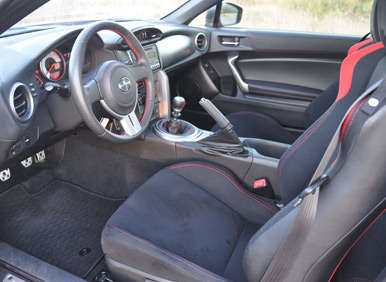
2013 Scion FR-S Review: Powertrain
What’s New for 2013:
- Subaru-sourced boxer four-cylinder engine
- 200 horsepower
- 2,758-pound curb weight
How Does It Go:
Because a horizontally opposed engine design, also referred to as a boxer engine for the way the pistons jab outward from the crankshaft toward the sides of the car rather than upward as in an inline- or V-type engine, is flat and compact, it possesses a lower center of gravity than more common kinds of powerplants. A lower center of gravity benefits vehicle handling, and this benefit is why Porsche steadfastly employs boxer engines in its sports cars.
Unlike Porsche, Subaru uses boxer engines exclusively. Their flatter and more compact design offers a handling benefit, yes, but it also allows Subaru to provide impressive ground clearance for models such as the Forester, Outback and the new XV Crosstrek, giving these crossovers more off-roading capability than their direct competitors.
Obviously, for the Scion FR-S, Toyota did not care about ground clearance. It wanted a Subaru boxer engine for its low center of gravity and, as installed in this low-slung sports car, the result is impressive. The Scion’s center of gravity is lower than a Porsche Cayman, and within half an inch of a Porsche 911 GT3.
This is all well and good, and while 200 horsepower in a 2,762-lb. vehicle is nothing to scoff at, that power peaks at a lofty 7,000 rpm and torque measures just 151 lb-ft. at 6,600 rpm. Launch the FR-S, row the outstanding six-speed manual gearbox, and speed builds in a linear, but rather dull fashion. There’s no doubt that the FR-S is quick, and it certainly is a pleasure to drive – in part because of the engine’s characteristic grumble and vibration – but acceleration is not thrilling. I’m betting a turbocharger would solve that problem.
That said, this direct- and sequential port-injected motor delivers impressive fuel economy, a good thing considering that it requires premium unleaded. I averaged 26.3 mpg over several hundred miles of driving, much of that spent flogging the car on the best roads the Santa Monica Mountains have to offer.

2013 Scion FR-S Review: How It Drives
The Scion FR-S exists to deliver the pure, unadulterated joy of driving, and it mostly succeeds. After slipping behind the steering wheel and finding a perfect driving position, the driver twists the key and the boxer engine fires to life. If you’ve never experienced the pleasure of driving a vehicle equipped with this type of powerplant, you’re missing out. It grumbles and vibrates, delivering a tactile and aural mechanical symphony that, frankly, is likely only appreciated by driving enthusiasts.
Depress the surprisingly solid clutch, select first gear, and release. The drivetrain connects with authority and the FR-S launches with verve. We’ve talked about how the car is quick rather than fast, with linear rather than progressive power delivery, and how horsepower and torque peaks up near redline. The result is a car that feels willing, if not quite eager, but it sounds and feels terrific as revs climb.
Head into the hills, and the Scion FR-S displays crisp, responsive steering free of electric-assist liability. The view forward is exceptional, the fender blisters providing excellent reference points, the thin A-pillars and generous side glass ensuring clear sightlines around blind corners.
Grip proved impressive on a 100-degree day, but on a couple of occasions the stability control system kicked in unexpectedly. The standard 215/45R17 Michelin Primacy HP tires rarely squeal to reveal possible extra-legal cornering speeds, but the transition from stick to slide is abrupt, so be sure to keep the safety net engaged unless you’re on a track. We also felt like body roll could use a little bit of extra control. Either complaint could certainly be resolved by TRD hardware, if it were available.
The Scion’s brakes proved indefatigable. We ran the FR-S as hard and fast as we safely could, and the four-wheel ventilated-disc brakes displayed no fade or shudder despite triple-digit temperatures. Impressive.
On the freeway, the MacPherson strut front and double-wishbone rear suspension provides a taut but not unforgiving ride. Unfortunately, on the grooved concrete used to construct many Los Angeles expressways, the tires hunt just enough to reveal a hint of on-center disconnectedness in the electric steering.
Around town, the FR-S proves nimble. Reversing from slanted parking spaces, however, can be difficult due to the thick rear pillars and the big right front seat headrest and bolsters. A reversing camera sure would be nice to have in such situations.
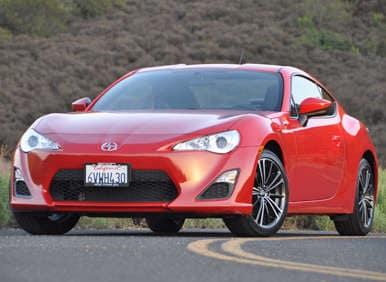
2013 Scion FR-S Review: Final Thoughts
Friends asked me what this car is like to drive. My reply: “It’s like a Mazda Miata or a Honda S2000, but without the pesky skin cancer.” Later, after screaming up and down mountain roads for a morning, it occurred to me that the Scion FR-S is actually more akin to a much-improved Mazda RX-8. It is less expensive, better looking, just as much fun to drive, more fuel efficient, and provides a similarly mechanical sound and feel as it goes about its business.
In fact, driving the FR-S reminded me of the race-prepped Toyota Celicas that I lapped around Willow Springs while attending my first professional driving school. The car feels, for the most part, track-ready right out of the box.
Given the Scion’s attractive price and the fixed roof, I would absolutely place one of these on my short list if ever I elected to sell my Miata.

2013 Scion FR-S Review: Pros and Cons
Pros:
- Front-engine, rear-drive, sports car
- Fantastic fun to drive
- Appealing price tag
- Impressive fuel economy
Cons:
- Useless back seat
- Requires premium fuel
- Not as thrilling as it could be
- Radio controls
Scion provided the vehicle for this review
Photos by Christian Wardlaw
